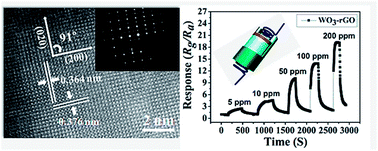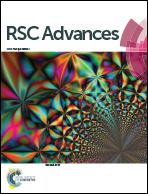Controllable synthesis and enhanced gas sensing properties of a single-crystalline WO3–rGO porous nanocomposite†
Abstract
In this paper, we report on a facile hydrothermal approach combined with a subsequent annealing process for the controllable synthesis of a single-crystalline WO3–rGO porous nanocomposite. The crystal structure, morphology and chemical composition of the as-obtained product were well-characterized by X-ray diffraction, transmission electron microscopy, X-ray photoelectron spectroscopy, Fourier transform infrared spectroscopy and Brunauer–Emmett–Teller analysis. The results indicate that this hybrid structure is composed of single-crystal WO3 porous nanoflakes with a size of 500 × 500 nm2 growing through or anchoring into a sheet-like rGO matrix. We explore the sensing performance of the gas sensor based on the as-synthesized product. Impressively, gas testing shows that the WO3–rGO nanocomposite exhibits an excellent kinetic response speed and good sensitivity toward NO2 and some volatile organic compound pollutants at a low temperature (90 °C). The pseudo 3-D structure provides many channels for gas diffusion and clearly enhances sensing properties. As such, this graphene-based composite shows promising potential as a high-performance gas sensing material for real-time gas detection.


 Please wait while we load your content...
Please wait while we load your content...